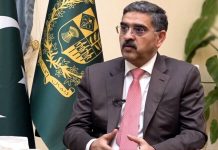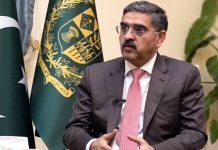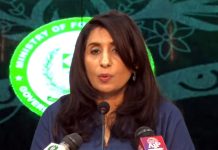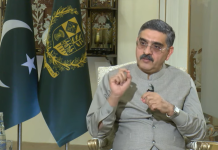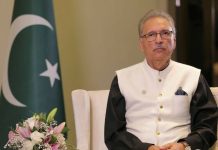
“When the incumbent government came to power, the economy was in a shambles. We are now making effort to pull the country out of the challenging conditions,” Sheikh said while unveiling the Economic Survey 2018-19 here in the federal capital. He explained that positive measures were being taken for the country’s economic stability. “Pakistan is endowed with natural resources including fertile land, long coast line, hardworking people, rich minerals and a number of other assets. But, the past governments entangled it in a quicksand of loans,” he said.
He said that the government inherited a weak economy with a total debt touching Rs 31,000 billion which were taken over the previous years. He said in the coming years, Rs 3,000 billion will have to be paid in terms of interest only on these loans. “Some 97 billion dollars were taken as external loans while the wealth producing capacity of the country increased by zero percent due to no raise in exports in all these years,” he said.
Sheikh said Rs 2,300 billion were spent beyond income which resulted in printing of more currency notes leading towards inflation. “This is an alarming situation for the country’s economy and the rupee is facing a lot of pressure,” he added.
Earlier, Sheikh shared the details of the pre-budget document. He spoke of the key economic indicators and the performance of different sectors of the economy as well as an overview of Pakistan’s economic progress in recent years.
The report highlighted the main features of the policies undertaken by the incumbent government, which, it said, were focused on bringing macro-economic stability and putting the country on a growth trajectory.
According to the economic survey, actual growth in agriculture sector was recorded at 0.85% as opposed to target growth of 3.8%. Actual growth of major crops was recorded at negative 6.55% as opposed to target growth of 3%. For other various crops, the actual growth was recorded at 1.95% as opposed to target growth of 3.5%. In cotton ginning, the actual growth was recorded at negative 12.74% as opposed to target growth of 8.9%.
The actual growth of livestock was recorded at 4% as opposed to target growth of 3.8%. In fishing sector, the actual growth was recorded at 0.79% as opposed to target growth of 1.8%.
In industries sector, the actual growth was recorded at 1.4% as opposed to target growth of 7.6%. In mining, the actual growth was recorded at negative 1.96% as opposed to target growth of 3.6%. In small industries, the actual growth was recorded at 8.2% in line with the target growth.
In construction sector, the actual growth was recorded at 7.57 percent as opposed to target growth of 10%. In services sector, the actual growth was recorded at 4.71% as opposed to target growth of 6.5%. In wholesale and groceries businesses, actual growth was recorded at 3.11% as opposed to target growth of 7.8%. In transport, storage, and communications sector, the actual growth was recorded at 3.34% as opposed to target growth of 4.9%. In finance and insurance, the actual growth was recorded at 5.14% as opposed to target growth of 7.5%. In housing services, the actual growth was recorded at 4% in line with the target growth. In general government services, the actual growth was recorded at 7.99% as opposed to target growth of 7.2%.
According to the economic survey, the total revenue at Rs 3,583.7 billion (9.3% of GDP) showed almost 0% growth from July-March 2019, while growth in total expenditures was 8.7%. The fiscal deficit was recorded at 5% of the GDP compared to 4.3% in the corresponding period last fiscal.
“Decelerated performance of total revenues primarily was due to marginal growth of 1.8% in tax revenues and negative growth of 16.7% in non-tax revenues,” the survey explained.
The Federal Board of Revenue’s tax receipts from July-April 2019 remained at Rs 2,976 billion against Rs 2,922.5 billion in the corresponding period last year, registering a growth of 1.8%. “Actual tax collection during first 10 months of the CFY remained at 67.7% of revised target of Rs 4,398 billion,” the document said, adding that the provincial revenue collection rose by 1.5% from July-March 2019.
The government’s total expenditure increased by 8.7% from July-March 2019 to Rs 5,506.2 billion (14.3% of GDP) against last year’s spending of Rs 5,063.3 billion (14.6% of GDP). Current expenditure posted growth of 17.7% to Rs 4,798.4 billion (12.4% of GDP).
The federal and provincial governments’ current expenditures grew by 19.9% and 13.7% respectively during the period under review. Development expenditure decreased to Rs 655.9 billion this fiscal compared to last year’s expenditure of Rs 993.3 billion, exhibiting 34% negative growth compared to 23.6% positive growth recorded last year.
The Public Sector Development Programme (PSDP) share in total development expenditure stood at 88% or Rs 578.5 billion in the first nine months of the fiscal year. The same period last year saw Rs 931.4 billion expenditure. This year’s PSDP expenditure saw a 37.9% decline, while last year witnessed 24.7% growth in PSDP spending. The federal and provincial PSDP decreased by 14.5% and 52.2% respectively during July-March 2019 compared to the same period last year.
According to the document, exports fell by 1.9% despite exchange rate depreciation, while imports declined by 4.9%. “This helped in reducing the trade deficit by 7.3% during July-April FY18-19, while it had shown an expansion of 24.3% during the corresponding period last year,” it stated.
The current account deficit contracted by 27% from July-April 2019, while it had expanded by 70% in the corresponding period last fiscal year. “Workers’ remittances played a major role in containing the current account deficit to 4.03% of GDP,” the report said.






